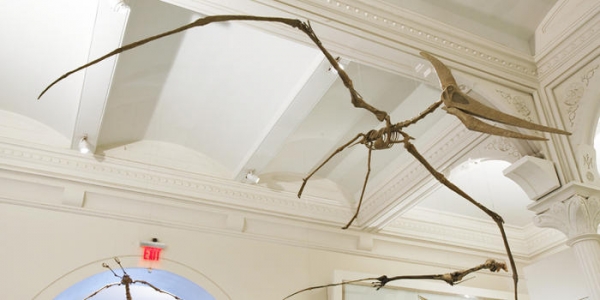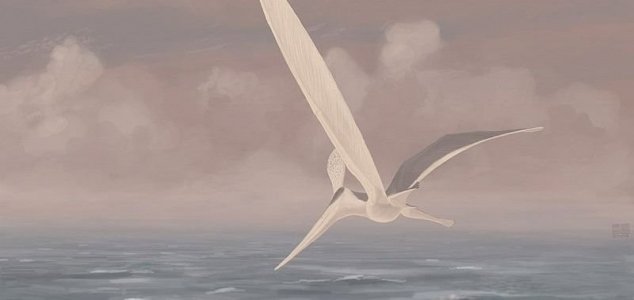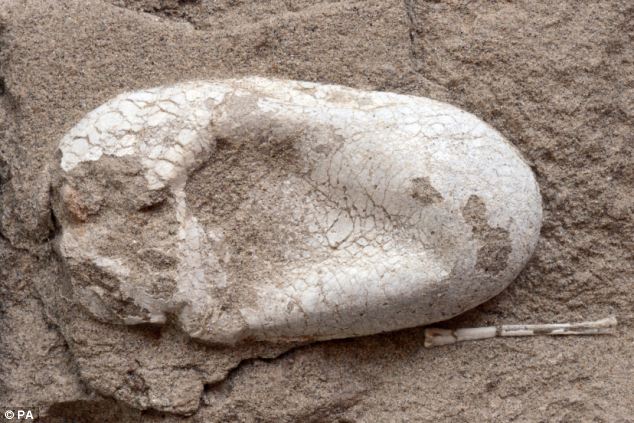It looks like you're using an Ad Blocker.
Please white-list or disable AboveTopSecret.com in your ad-blocking tool.
Thank you.
Some features of ATS will be disabled while you continue to use an ad-blocker.
8
share:
I was pondering whether to place this in the Science or Fragile Earth Forum. But I think it fits in both places.


Source:
www.unexplained-mysteries.com...
3 Dimensional-wow!
How on earth did it remain like this for 120 million years?
I wonder what tests they will do, and are they going to try to use the fossils to create/ clone pterosaur eggs...
I thought this was interesting news.
The more you know...
Happy Sunday Everybody.

Palaentologists have uncovered the best preserved cluster of three dimensionsal fossils ever discovered.
Located in the Xinjiang Uygur Region, the eggs belong to a new genus of pterosaur called Hamipterus tianshanensis and date back 120 million years to a time when these giant winged reptiles would have ruled the prehistoric skies.
The find is particularly significant because the eggs have been found in a three-dimensional state as oppose to two-dimensional like most fossils.
"This is definitely the most important pterosaur site ever found," said paleontologist Zhonghe Zhou. "Five eggs are three-dimensionally preserved, and some are really complete."
The site is thought to have been a pterosaur colony that was wiped out by a particularly violent storm. At least 40 individuals have been identified however it is believed that there would have been several hundred living there at its peak.
The researchers concluded there could have been hundreds at its peak.
"One of the significant (aspects) of this discovery - hundreds of individuals and eggs together from one site - is that it confirmed that pterosaurs were gregarious, and the population size is surprisingly large," Zhou said.
"I have been truly amazed by the abundance of bones and the number of eggs as well the great potential of more discoveries from the site," said Zhou.

"I have been truly amazed by the abundance of bones and the number of eggs as well the great potential of more discoveries from the site," Zhou told Reuters.
The team's new study is published in the journal Current Biology. The researchers examined a new species of pterosaur, named Hamipterus tianshanensis, which roughly means "the wing of Hami, in the Tianshan mountains."
Source:
www.unexplained-mysteries.com...
3 Dimensional-wow!
How on earth did it remain like this for 120 million years?
I wonder what tests they will do, and are they going to try to use the fossils to create/ clone pterosaur eggs...
I thought this was interesting news.
The more you know...
Happy Sunday Everybody.
edit on 8/6/2014 by Rainbowresidue because: fixed source
a reply to: Rainbowresidue
Very cool find.
It's still made of rock just not compressed in to a pancake,, so i don't think they could clone anything from that rock.
PICTURE SOURCE
Very cool find.
I wonder what tests they will do, and are they going to try to use the fossils to create/ clone pterosaur eggs...
It's still made of rock just not compressed in to a pancake,, so i don't think they could clone anything from that rock.
PICTURE SOURCE
edit on 8-6-2014 by Mianeye because: (no reason given)
All we need now is a Pigzilla and then the ultimate bacon and egg breakfast will be ours!
Very cool find really. What a strange and different world it would have been. Oh for a time machine.
Your link wasn't quite working, I think this might be it Link
Here's a picture of one of those bad boys!

More Info
(edit) Mianeye, you must have beaten me by seconds!
Very cool find really. What a strange and different world it would have been. Oh for a time machine.
Your link wasn't quite working, I think this might be it Link
Here's a picture of one of those bad boys!

More Info
(edit) Mianeye, you must have beaten me by seconds!
edit on 8-6-2014 by Qumulys because: (no reason given)
a reply to: Rainbowresidue
So it's possible or likely that hundreds of these critters lived together in colonies, and hunted near each other. They must have filled the skies and air with sound and fury, signifying "RUN!" to all the little creatures and fish in the vicinity. I suppose when a large kill was made, or a fresh body found, they'd pile on by the dozens or hundreds to tear it apart. Nesting pairs may have been common. Nice OP, OP.
So it's possible or likely that hundreds of these critters lived together in colonies, and hunted near each other. They must have filled the skies and air with sound and fury, signifying "RUN!" to all the little creatures and fish in the vicinity. I suppose when a large kill was made, or a fresh body found, they'd pile on by the dozens or hundreds to tear it apart. Nesting pairs may have been common. Nice OP, OP.
Good find and very interesting - the 3D nature of the eggs should shed light on the growth and development of these animals.
Just add though, they won't be able to do any cloning from these eggs - they're just rock.
Just add though, they won't be able to do any cloning from these eggs - they're just rock.
Thank you all for the replies and for educating me on the subject.
It's a shame they won't be able to do anything with the eggs besides display them in a museum.
Oh, well. It can still help them study this species, and learn more about their habits.
To Mianeye
Thank you for the great photo.
It's a shame they won't be able to do anything with the eggs besides display them in a museum.
Oh, well. It can still help them study this species, and learn more about their habits.
To Mianeye
Thank you for the great photo.
edit on 8/6/2014 by Rainbowresidue because: (no reason given)
a reply to: Aleister
Yeah, I kinda picture them in my head as being more akin to vultures rather than an eagle type bird. It seems like the beak design would be too heavy for fast from the sky attacks, but would be excellent for digging around and tearing out bits from the inside carcasses of already downed prey.
Yeah, I kinda picture them in my head as being more akin to vultures rather than an eagle type bird. It seems like the beak design would be too heavy for fast from the sky attacks, but would be excellent for digging around and tearing out bits from the inside carcasses of already downed prey.
Hmm after reading a little closer they are not exactly rock, more like dirt and flexible, 120 Mill. years and still soft, that's amazing but still
not capable of producing clones.
The eggs have a flexible structure with a thin exterior shell of calcium carbonate and an interior membrane that is soft and thick.
a reply to: Qumulys
The beak design would be good for fishing, frogging, and toading. They could skim above the water, take a big dip into it with their beaks, and still keep their heads above water (like today's cranes). And to catch the little mammals or lizards running on the ground they wouldn't even have to bend their heads. With those beaks it wouldn't be a problem to hunt for insects in deep foliage, or to clean themselves of pests. A great design, that beak.
The beak design would be good for fishing, frogging, and toading. They could skim above the water, take a big dip into it with their beaks, and still keep their heads above water (like today's cranes). And to catch the little mammals or lizards running on the ground they wouldn't even have to bend their heads. With those beaks it wouldn't be a problem to hunt for insects in deep foliage, or to clean themselves of pests. A great design, that beak.
A little more information I found on Pterosaurs and their eating habits. Seems like they had some vulture like qualities to them as well.
Pterodactyls were carnivores and scavengers. In the first few months of their life, they ate insects. As an adult they ate a lot of fish which they would catch from the surface of the water by dipping their long beaks in as they flew over, but they would also eat dinosaurs who were already dead.
new topics
-
I hate dreaming
Rant: 1 minutes ago -
Is the origin for the Eye of Horus the pineal gland?
General Conspiracies: 1 hours ago -
Man sets himself on fire outside Donald Trump trial
Mainstream News: 1 hours ago -
Biden says little kids flip him the bird all the time.
2024 Elections: 2 hours ago -
The Democrats Take Control the House - Look what happened while you were sleeping
US Political Madness: 2 hours ago -
Sheetz facing racial discrimination lawsuit for considering criminal history in hiring
Social Issues and Civil Unrest: 2 hours ago -
In an Historic First, In N Out Burger Permanently Closes a Location
Mainstream News: 4 hours ago -
MH370 Again....
Disaster Conspiracies: 5 hours ago -
Are you ready for the return of Jesus Christ? Have you been cleansed by His blood?
Religion, Faith, And Theology: 7 hours ago -
Chronological time line of open source information
History: 8 hours ago
top topics
-
In an Historic First, In N Out Burger Permanently Closes a Location
Mainstream News: 4 hours ago, 14 flags -
The Democrats Take Control the House - Look what happened while you were sleeping
US Political Madness: 2 hours ago, 9 flags -
Thousands Of Young Ukrainian Men Trying To Flee The Country To Avoid Conscription And The War
Other Current Events: 15 hours ago, 8 flags -
A man of the people
Medical Issues & Conspiracies: 10 hours ago, 8 flags -
Biden says little kids flip him the bird all the time.
2024 Elections: 2 hours ago, 6 flags -
Man sets himself on fire outside Donald Trump trial
Mainstream News: 1 hours ago, 5 flags -
4 plans of US elites to defeat Russia
New World Order: 11 hours ago, 4 flags -
Are you ready for the return of Jesus Christ? Have you been cleansed by His blood?
Religion, Faith, And Theology: 7 hours ago, 3 flags -
Is the origin for the Eye of Horus the pineal gland?
General Conspiracies: 1 hours ago, 3 flags -
Sheetz facing racial discrimination lawsuit for considering criminal history in hiring
Social Issues and Civil Unrest: 2 hours ago, 3 flags
active topics
-
Is the origin for the Eye of Horus the pineal gland?
General Conspiracies • 3 • : purplemer -
I hate dreaming
Rant • 0 • : FlyersFan -
MH370 Again....
Disaster Conspiracies • 8 • : Lazy88 -
Do we live in a simulation similar to The Matrix 1999?
ATS Skunk Works • 27 • : purplemer -
Thousands Of Young Ukrainian Men Trying To Flee The Country To Avoid Conscription And The War
Other Current Events • 27 • : Xtrozero -
12 jurors selected in Trump criminal trial
US Political Madness • 86 • : ImagoDei -
911 emergency lines are DOWN across multiple states
Breaking Alternative News • 8 • : nugget1 -
Marjorie Taylor Greene Files Motion to Vacate Speaker Mike Johnson
US Political Madness • 64 • : interupt42 -
The Democrats Take Control the House - Look what happened while you were sleeping
US Political Madness • 20 • : CriticalStinker -
Man sets himself on fire outside Donald Trump trial
Mainstream News • 17 • : FlyersFan
8

